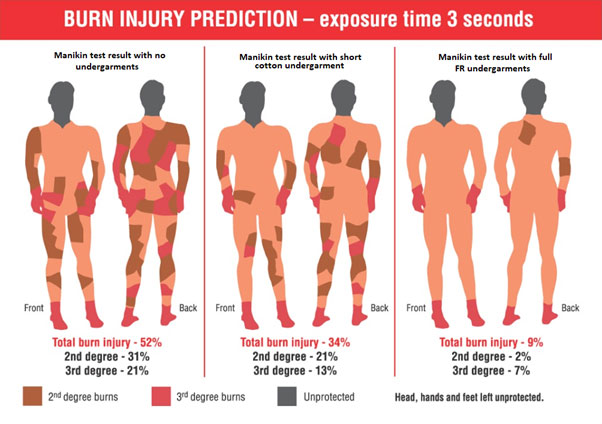Importance of Base Layers with Flame Resistant & Arc-Rated Clothing
- What do standards say about undershirts or base layers with Flame Resistant Clothing?
- What are the options available for better protection?
- How to understand the best practice?
These are the question we come across very often and for good reasons. It is not uncommon to wear an undergarment round the clock for added comfort or warmth. But how does this common practice apply in work environments or industrial activities where there is a possible hazard associated?
What do the standards say about the undershirt or base layers?
Common industry standards do not specify the use of a base layer, as long as the outer layer is FR and meets the standards associated with the hazard predicted in the industry. However, some industry standards do recommend that the base layers should not be made in the material which can melt under exposure to industrial hazards.
We are all familiar that the use of a meltable base layer, even below an FR/AR garment, can cause major damage in case the impact of fire or arc flash reaches the base layer. This will lead to rapid ignition, and melting of textile material which can stick to the wearer’s skin thus causing severe injuries. The AR garments can protect the wearer from any second-degree burn if the rating of the outer garment was higher than the incident energy of the arc. However, the base layer igniting even for a short duration could dramatically change the outcome – from no injury to serious burns. Burns caused by liquids like molten polymers of textile material can most often lead to third-degree burns which might require skin grafting, however, sometimes these injuries are completely irreparable.
What are the options available for better protection?
If we think of eliminating the meltable base layers, what are the possible options available?
OPTION 1: NO BASE LAYER
- You comply with requirements as per standards
- No cover except the outer layer in case of an accident
- Possibilities of burn injuries in case of an unbuttoned shirt front or sleeves, an improper overlap of Shirt & Trousers, creating room for fire or arc flash to sneak inside
- Can even lead to severe damage to the wearer’s skin
OPTION 2:100% COTTON BASE LAYER
- You comply with requirements as per standards
- Cotton is flammable and hence the risk of burn injury is still a possibility
- A better protection level as compared to option 1
OPTION 3:FLAME-RESISTANT / ARC-RATED BASE LAYER
- In case of an accident, well equipped to reduce impact or damage, as both layers work towards better protection
- FR/AR base layer will add to the arc rating of the outer layer and thereby provide higher arc protection levels
To explain this better please check the below image of an instrumented manikin showing possible burn injury in all 3 cases. This would very clearly substantiate the requirement of wearing FR undergarments beneath the FR / AR clothing systems for best protection.

From the above images, it’s quite evident that the chances of 2nd and 3rd burn injuries are substantially higher and can be possible in case of no base layer which can eventually lead to life loss. In the case of Cotton undershirts, this risk is reduced by almost 35% which further reduces to almost negligible in case of the use of Flame Resistant undergarments.
Tarasafe with its three decades of experience highly recommends the use of FR base layers for superior comfort and higher protection levels. For further information on our base layers, kindly connect with us today.


Leave a Reply